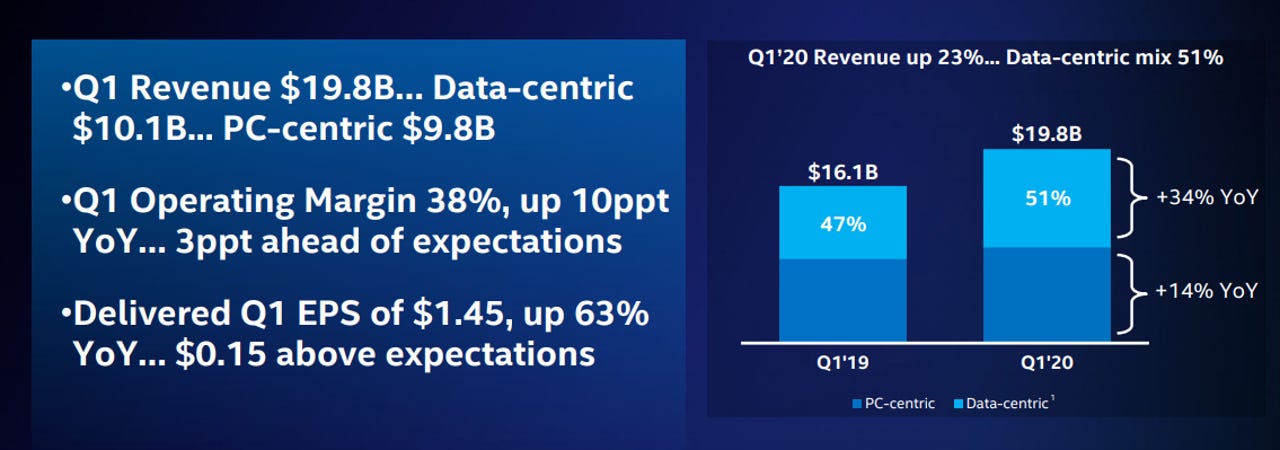Intel reports strong Q1 with solid growth in cloud service provider sales

Intel reported strong first quarter financial results on Thursday, in part thanks to strong sales with cloud service providers. The company's Data Center Group (DCG) saw revenue up 43 percent year-over-year, which includes 53 percent year-over-year growth in cloud service provider revenue.
Intel's non-GAAP earnings per share came to $1.45 on total revenue of $19.8 billion, up 23 percent year-over-year.
Analysts were expecting earnings of $1.28 on revenue of $18.7 billion.

"Our first-quarter performance is a testament to our team's focus on safeguarding employees, supporting our supply chain partners and delivering for our customers during this unprecedented challenge," CEO Bob Swan said in a statement. "The role technology plays in the world is more essential now than it has ever been, and our opportunity to enrich lives and enable our customers' success has never been more vital. Guided by our cultural values, competitive advantages and financial strength, I am confident we will emerge from this situation an even stronger company."
Intel said it maintained essential factory operations with greater than 90 percent on-time delivery amid the COVID-19 pandemic.
"We only allow employees in our factories who are essential to the factory's operations," Swan said on a conference call Thursday. "By design, our clean rooms and factories are among the cleanest places in the world."
The company said its "data-centric" revenue grew 34 percent year-over-year, while PC-centric revenue grew 14 percent.
Its "data-centric" businesses include the Data Center Group, the IOT Group, Mobileye, the Non-Volatile Memory Solutions Group (NSG) and the Programmable Solutions Group (PSG). That's effectively everything outside of its PC business.
Revenue from the Data Center Group in Q1 came to $7 billion.
While cloud sales grew by 53 percent, Intel's communication service provider business grew by 33 percent, Swan said on Thursday's call. These two segments now drive 70 percent of all Data Center segment revenue.
"Through this crisis, the world's cloud and network infrastructure has delivered massive scaling to support vital workloads for businesses and consumers," Swan said. "Cloud-delivered applications seen as convenience as recently as a quarter ago, such as online shopping and video collaboration, has now become indispensable."
Intel entered the year after seeing strong cloud sales in the second half of 2019, expecting cloud providers to "go through their normal digestion stage" later in 2020, Swan said. However, Q1 was stronger than expected.
"In our raised outlook for Q2, we expect that strong demand to continue and possibly even going into the second half of the year," the CEO said.
Meanwhile, the Client Computing Group (Intel's PC business) brought in revenues of $9.8 billion. Intel said its 14 percent growth exceeded expectations thanks to improved CPU supply and demand strength, as consumers and businesses rely on PCs for working and learning at home. Notebook volumes up over 20 percent in the quarter, Intel CFO George Davis said on Thursday's call.
"We had expected solid PC in the first half," he said. "With COVID, it's been even stronger and heavily weighted toward notebooks."
Intel's memory business (NSG) brought in Q1 revenue of $1.3 billion, up 46 percent.
The Internet of Things Group achieved revenues of $883 million, down 3 percent over the year prior.
Intel's PSG (programmable solutions group) brought in $519 million, up 7 percent.
Mobileye revenue in was $254 million, up 22 percent.
For the second quarter, Intel is giving an outlook of $18.5 billion in revenue with a non-GAAP EPS of $1.10. The company says it is providing full-year guidance given the significant economic uncertainty.
Intel provided a lengthy caveat to its forward-looking statements regarding the COVID-19 pandemic:
The COVID-19 pandemic could materially adversely affect Intel's financial condition and results of operations. The pandemic has resulted in authorities imposing numerous unprecedented measures to try to contain the virus. These measures have impacted and may further impact our workforce and operations, the operations of our customers, and those of our respective vendors, suppliers, and partners. There is considerable uncertainty regarding the business impacts from such measures and potential future measures. Restrictions on our access to or operation of our manufacturing facilities or on our support operations or workforce, or similar limitations for our vendors and suppliers, can impact our ability to meet customer demand and could have a material adverse effect on us. Similarly, current and future restrictions or disruptions of transportation, or disruptions in our customers' operations and supply chains, may adversely affect our results of operations. The pandemic has significantly increased economic and demand uncertainty. It is likely that the current outbreak and continued spread of COVID-19 will cause an economic slowdown, and it is possible that it could cause a global recession. Given the significant economic uncertainty and volatility created by the pandemic, it is difficult to predict the nature and extent of impacts on demand for our products. The pandemic has led to increased disruption and volatility in capital markets and credit markets, which could adversely affect our liquidity and capital resources. A slowdown or recession can also result in adverse impacts such as increased credit and collectibility risks, adverse impacts on our suppliers, failures of counterparties, asset impairments, and declines in the value of our financial instruments. The spread of COVID-19 has caused us to modify our business practices. There is no certainty that such measures will be sufficient to mitigate the risks posed by the virus, and illness and workforce disruptions could lead to unavailability of our key personnel and harm our ability to perform critical functions. The degree to which COVID-19 impacts our results will depend on future developments, which are highly uncertain and cannot be predicted, and our Business Outlook is subject to considerable uncertainty